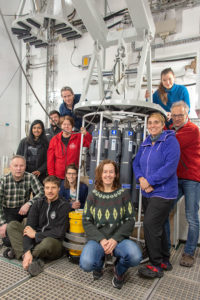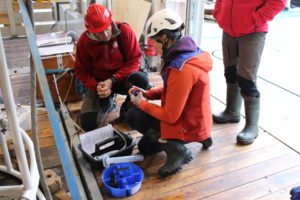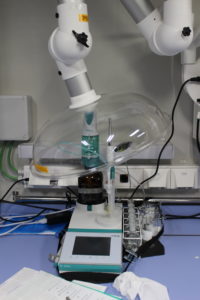There were so many exciting things happening on the ship that I almost forgot to write about the main work that I have been doing during this cruise: CTDs! The fact that the sea ice conditions didn’t allow us to deploy the mooring that I brought, doesn’t mean I could lean back and have holidays. CTDs are almost taken all of the time and our team was split up in 2 shifts. I always worked from 12:00 – 16:00h and from 20:00 – 04:00h, which means that we basically only got a few hours of daylight (it was dark from about 18:00 – 04:00 UTC). This can be tiring, but from the CTDs we can learn a lot about the physics, chemistry and biogeochemistry in the ocean, which again is important when studying oceanography and the ecosystem in the ocean.

But now a deeper explanation of the work:
CTD means Conductivity (Salinity) -Temperature-Depth. You can imagine a big yo-yo that goes all the way to the ocean floor and up again, measuring those three values throughout the whole water column. Since we already send down those sensors (which can takes about 100 min for 3000 m water depth), we can equally do more measurements on the way down. We had also an LADCP (Lowered Acoustic Doppler Current Profiler to measure velocity), a flourometer, transmissometer, Biospherical/Licor and an oxigen sensor. In addition, there are Niskin bottles attached to the CTD frame (the grey bottles on the picture), which take water samples at different depths. The water samples are used for calibration of the sensors, but also to measure biogeochemistry and chemistry in the water.
In total, we did 65 CTDs and took about 3800 water samples from the Niskin bottles to analyse them afterwards in the lab. Whenever the CTD came up from it’s yo-yo dive, we had to take the water samples, filter them and analyse. It was my task to analyse the concentration of dissolved oxygen in the water samples, which tells about the age of the water and the biological activity. Super exciting! Sometimes we were just done with the tasks, when the CTD came on deck again to do it all over again at the next location.
I am sure, we will have interesting results, once we have looked at the data more closely!


